You are reading the older HTML site
Positive Feedback ISSUE
january/february 2008

Just What the Doctor Ordered …The Marantz SA-7S1 SACD Player
Dr. Sardonicus
[All photographs by the eminent Doc S. unless otherwise noted; cartoons by the inestimable Dan Zimmerman; all image processing by the improbable Doc Robinson]
Introduction
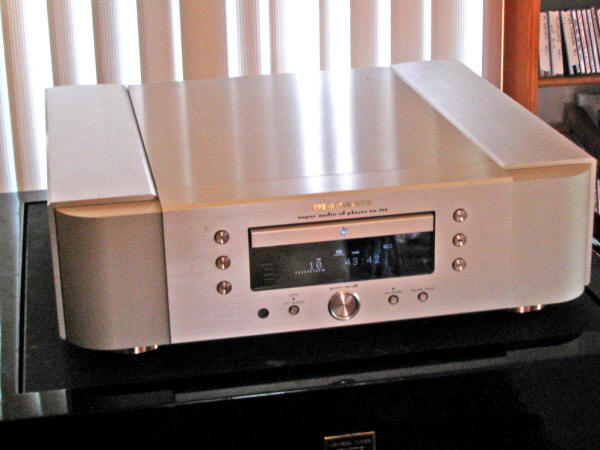
Way back in PFO Issue 32, I introduced the new Marantz SA-7S1 SACD player (see www.positive-feedback.com/Issue32/marantz_sa7.htm). To my knowledge it was the first major review of this extraordinary new player in a US audio magazine.
Because I did not feel the machine was completely run in, the review was framed as a "preview," basically touching on what I thought were the most salient performance elements in the still-evolving player, rather than providing an in-depth examination. Shortly after, there was a follow-up review by a new PFO contributor, Mark Lawton, along with his experiences with having the SA-7 modded shortly after purchase.
At this point in time, I now have over a thousand hours on the machine, and I have vetted my experiences with a number of invited listeners, including PFO Editor-in-Chief, David Robinson, and PFO Senior Technical Editor, Jennifer Whitewolf-Crock (also owner of JENA Labs), as well as a host of "non-audiophile" listeners.
The most significant outcome of this extended invitation for reactions and input from others is the distinct lack of comments on the machine itself, once the "ooh'ing" and "ah'ing" over the visual aesthetics of the piece (which are truly toothsome) comes to an end. Instead, what mostly happens are long listening sessions, where we move back and forth amongst genres, formats, and eras as easily as the natural, comfortable conversation amongst good friends. These listening sessions typically extended well beyond the initial planned intervals.
The most recent with David Robinson ran just under five hours, and probably would have run longer, were he not due at another engagement.
So, let me repeat this … five hours, and this was not the typical audiophile session, in which the time is mostly spent in talk, punctuated by thirty seconds of this and that, framed by long periods of swapping out components and cables. We listened to some complete discs (such as the simply perfect Joe Weed and the Vultures SACD); we listened to the majority of cuts from many more discs (ranging from plain Jane CD's, such as Blue October, AC/DC and The Nylons), and of course, there were the audiophile approved torture-test cuts (such as "Laughing," from David Crosby's, If I Could Only Remember my Name).
And, at the risk of drawing approbation from the tofu-sucking, granola-crunching conservatives who react with shock and horror to SPL's over 85dB …we listened at levels appropriate for the subject matter the entire time (I will leave it to your imagination as to what "appropriate" means in the context of AC/DC's "Can't Stand Still").
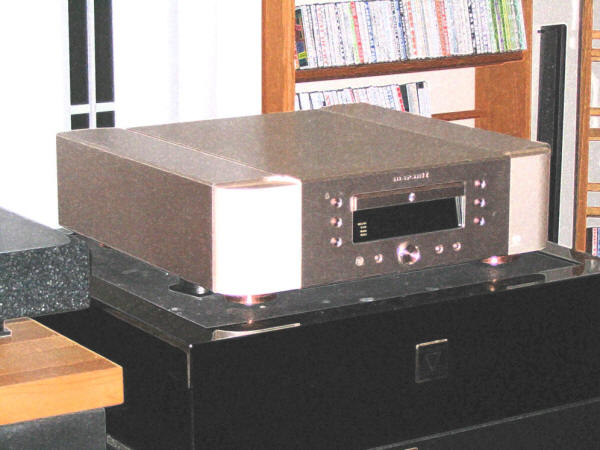
"Give me the luxuries of life and I will
willingly do without the necessities."
– Frank Lloyd Wright
Of course, during this time with David, there was a French press carafe of slow-ground El Salvador Cerro Las Ranas; pasta with locally made Italian sausage; freshly made coffee-fudge ice cream from my ancient SIMAC gelato machine (concocted with real vanilla beans, freshly brewed Kenya AA coffee and Ghirardelli's fudge …David called it "evil!"); as well as a very nice VSOP brandy and some Apricot tea. I describe this solely in the spirit of full disclosure, lest it be alleged that I applied mind-altering substances to the listening session and did not report same. "Full disclosure equals no conflict of interest." - David Robinson
I know, I know …sometimes I need to leave a trail of breadcrumbs back to my point. My point is that when real magic happens in audio, the equipment simply disappears into the background and the music takes over. This is because our attention is not drawn either to deficits in reproduction, or the artificial "hype-ing" that makes the equipment the star, not the music.
This effect is ever-present with the Marantz SA-7S1 in both SACD and RBCD modes. While I think the allegations of the equality and even superiority of RBCDs to SACDs is patently absurd, and have said so, unequivocally, a number of times previously, the Redbook performance of the SA-7 is as satisfying as the limitations of this limited medium allow.
I listen more to CDs because more of the music I listen to is available in that format, and I have decades of amassing CDs which I could never afford to replace, even if they were available on SACD. As good as the Redbook performance of the Marantz is, I am never ambivalent about which format is superior. In practical terms, I move back and forth among CD, vinyl and SACD, simply as a function of what music I wish to hear. But with the Marantz, my enjoyment is no more diminished by CDs than when I listen to recordings from the past. From The Beau Brummels, through the Searchers, and even some obscure recordings I have of 20s and 30s blues …regardless of format or age …the music is presented in an unobscured but loving manner.
Differentiating Excellence
My reason for emphasizing this sine qua non characteristic (the disappearing act) of the Marantz player is to provide a cogent framework to understand my assessment, as well as to help inform readers as to whether or not they might expect to experience the same, unqualifiedly positive response I have to the Marantz SA-7S1.
David Robinson and I have often spoken of the various "house" characteristics of the relatively small number of manufacturers producing what we consider to be the "best of the best" of SACD players. This is a conversation that is still in process, and we hope it will lead to an article exploring this idea more fully …that at the highest levels of engineering and manufacturing of SACD players, there are differences among the machines best articulated as flavors, rather than absolute qualitative differences.
In other words, be it Meitner (EMM Labs), Lindemann, Sony, Marantz, Teac Esoteric, Halcro, Cary Audio, Ayre, Accuphase, etc., a potential buyer is faced with a number of truly fine machines, each of which varies in its presentation to a degree significant enough to polarize more sophisticated listeners. This is true even within lines, such as the new Esoteric DV-60 universal player, which is my current favorite among the Esoterics.
This delightful embarrassment of riches means there is really no "best": it depends upon your individual aesthetic. A case can be made for each of the top-of-the-line players out there. But, it is very likely one of them will be a much better fit for you than the others.
I recently saw a short piece on the Marantz SA-7 acknowledging its virtues, but saying (based on two or three specific criteria the writer valued), that it was not the "best" player out there. I think this is simply an inaccurate way of saying that it was not this specific reviewer's preference.
I have received quite a bit of feedback about my initial review of the SA-7 and the Marantz player in general, and most of it is quite positive, but there certainly were vehemently stated contrary opinions, which is not all that unusual. Audiophiles tend to describe reality in bipolar terms of what they like, with whatever they don't like being lumped into the category of "crap," be it equipment, music and reviews and …sometimes even people.
So, let's look at this issue of preferences a bit further. For purposes of argument, let's assume that on one side of the "flavor" spectrum of high end SACD player, we have machine X, which is characterized by a "Technicolor" vividness and sparkle that creates an immediate "wowzers" reaction in listeners, followed by fatigue and eschewing any but the most pristinely recorded music.
At the other end of the spectrum is machine Y, which is rounded, soft and warm sounding. The polite nature of machine Y obscures some details on good recordings, and paints them more lushly than reality. It is much more forgiving of bad recordings and smoothes over their obvious flaws.
X has more detail, Y has less fatigue. X can sound overly harsh and brittle on bad recordings; Y is gentler, but less involving.
Now, I am exaggerating these extremes to make a point.
Scylla and Charybdis
Historically, these have been essentially the choices to be made …with most of the machines lining up pretty well towards one or the other end of the continuum.
Sadly, the music lovers …unable to tolerate the hype and fatigue of X …were relegated to the opposite side of the same coin (lack of musical neutrality), and both sides flock to after-market mods to try to get closer to their desired goal.
As to the "others," well, I think most of audio is catering to them, so they don't need my help.
I suspect that while I am not necessarily completely atypical as an audio enthusiast, I am not in the mainstream either. The virtues of accurate and complete reproduction (getting as much off of each recording as possible) drive me as much as the next person, but I am unwilling to wear the hair shirt of hyped detail and accelerated fatigue in order to achieve it.
Quite simply, I listen to such a broad cross section of recordings (formats, genres and recording quality), and I listen so much, that picking the X end of the spectrum leaves me tired and frustrated. I face an increasing; downward spiral in the actual time I spend listening to music, as well as unacceptably limiting what I listen to, when I do listen.
The Y end leaves me unmoved and bored, and frustrated again, because I know there is more there than I am getting. I can listen longer and to more stuff …but who cares? I may not be irritated, but I am not nourished or delighted either.
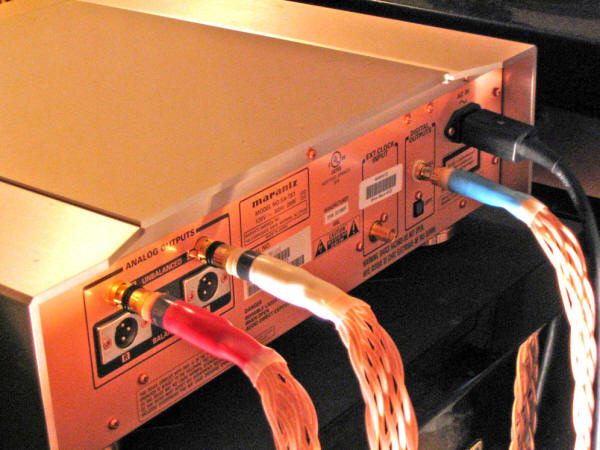
Up until I took receipt of the Marantz SA-7S1, the closest I had come to achieving some sort of livable balance between these two untenable extremes was the Lindemann 820 SACD player. It was silky and smooth, for sure, and I liked it a lot, as I made clear in my essays on that design. But it still fell to the Y side of the spectrum, and with the inexplicable oddness of dealing with Lindemann, the $12K plus price tag, and no clearly identified US distributor or service …well, c'est la vie.
The EMM Labs CDSA SE, Meitner's one-box player, certainly provided more resolution and excitement than the Lindemann, while not reaching the extreme levels of "X" I heard with the dCS and Esoterics. I did appreciate the additional detail and drive over the Lindemann's prettier, but more polite presentation. No question the Meitner took me further into recordings than the Lindemann—but at a price.
First of all, there is the issue of the limitations smaller manufacturers have on transports and the like. Mechanically, the Meitner was balky at times and not a whole lot of fun. Slow to respond to inputs, intolerant of disc variations, and unpredictably noisy …it eventually started to wear on me. It also had a tendency to highlight and emphasize recording imperfections in a way that had me listening less and less, and often reaching for the volume control.
Enter the Marantz
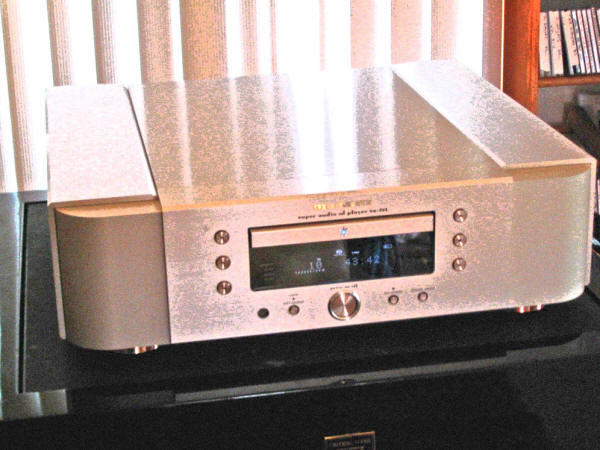
At a retail price of $6499, the SA-7S1 is significantly less expensive than its closest true competitors, which are all pretty much at or over $10K retail. Build quality and visuals are comparable or better than the competition. There have been some complaints about the remote which is not a heavy ingot of metal, but functionally I like the remote better than the other SACD players I have experienced …it is intuitive in operation, and the machine accepts inputs very responsively.
The machine is very fast to load and switch modes (usually five to eight seconds).
While the display is relatively small, it is very highly resolved and quite useful. It is defeatable, if you so choose.
There are some quirks. First, if you use the balanced outputs, the machine inverts phase (or "polarity," tipping the hat to Clark Johnsen) compared to its RCA outputs; this because Marantz is using an out-of-date convention for pinning of XLR connectors.
I spent a great deal of time going back and forth between the balanced and RCA outputs using comparable runs of Jena Labs cables, and I found very little difference. The phase (polarity) issue appears to be more recording-driven, than absolute, but since both the machine and my reference BAT preamp allow for inverting phase (polarity), it is really a non-issue for me.
There are some things you have to do at the machine (such as phase (polarity!) inversion) rather than with the remote, and switching filters and modes cannot be done in play.
The "filters" operate differently in CD and SACD mode (that is, they produce a different profile, so you may have to change filter settings between SACD and CD if you are so motivated). Frankly, the only meaningful shift I found was that Filter 3 for CD results in a bit more vivid presentation. I could not establish a clear preference for SACD filter settings.
I have heard some third-hand reports that static electricity produced effects in the player (occasionally failing to recognize a disc, for example), but in over a thousand hours of use I have experienced absolutely no such issues (and I used a wide mix of early generation CDs, CD-Rs, and SACDs of various vintages, etc.). If the disc is playable, the Marantz will play it.
In my most recent exchange with Marantz on the topic of reliability, I was told that only two machines had been returned in the initial US distribution. Both were for shipping-related damage. I suspect that this may have changed somewhat since the flood of new machines hitting the states since we last talked, but if this is an accurate report, it is still quite impressive reliability for a new product.
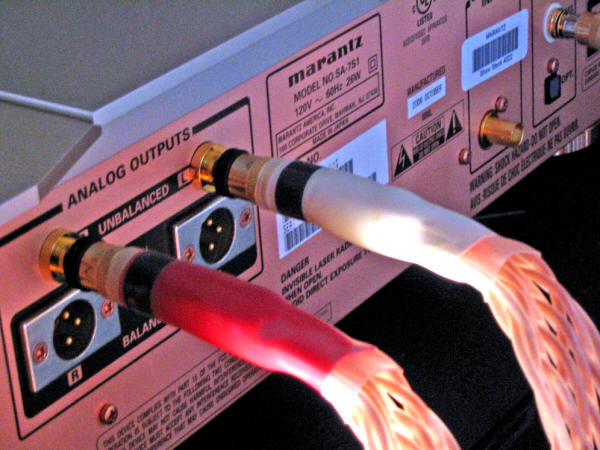
Providing a Context for Placing the Marantz along the "Flavor" Continuum
There is a reason (actually many reasons) why my work appears in the editorial portion of PFO, rather than in equipment reviews … but foremost among these reasons is that I choose (for various reasons) not to follow the commonly accepted formatting for doing equipment reviews.
One of those classic format expectations is to list the equipment used (which you can get here at PFO simply by looking at the staff system profiles at www.positive-feedback.com/staff.htm, if you are so inclined) and to always detail the music used (with, I guess, the assumption we all listen to at least some similar material). There is also the expectation of at least some pretense of stating inescapably subjective conclusions in faux-objective categorical ways (e.g., "This is better than, or inferior to …").
At this point we stand poised to plunge directly down the primary rat-hole of audiophilia: objective versus subjective analysis in reviews. After more personal effort than is rational, I have concluded this controversy is irresolvable and therefore pointless. It's like crunch versus smooth peanut butter …there is no reconciliation.
We each will believe what we believe and that is that. Except for the questionable relish in periodic and repetitive groin-kicking debates, I see no reason to continue to participate in this pointless conflict.
So, instead, I will be clear. I write about what I think and feel, and occasionally and judiciously vet and salt my perceptions with the input of various people I trust and allow into my home. I make every effort to be as reasonable and complete as possible in my examinations of equipment and music, but ultimately I am simply writing about my experiences in as clear and hopefully entertaining manner as I can.
I no longer make any pretense of pseudo-technical insight and, instead, rely on PFO Senior Technical Editor, Jennifer Crock, of JENA Labs to explain to me real engineering.
But since as Maude (Harold and Maude) once said, "Consistency really isn't a human trait" …
I am going to list the equipment used during this review…
Amplification: BAT VK-51-SE tube preamplifier (with JENA Labs EC-99 mod), BAT VK-600-SE SS power amplifier, Ming Da EL-34-AB integrated tube amplifier, LSA Statement hybrid integrated amplifier.
Speakers: VMPS RM-30-C planar/ribbon mains, HSU VTF-3- Mk III subwoofer, with turbo charger, and HSU MBM-12 mid-bass modules.
Isolation: Critical Mass Systems
Wire and AC: JENA Labs
Accessories: Two fluffy-butted Maine Coon cats, VSOP brandy and other libations, the simply indispensable Jena Labs Esoteric 3-D digital disc treatment and a lovely girlfriend with absolutely perfect ears. An Italian leather couch and a sheep skin cover to protect my delicate skin. (What? You don't listen in the nude?)
The Music
See, other than doing my occasionally voluminous music reviews (I believe I hold the uncontested world's freestyle record for the number of music reviews in a single issue of any magazine by a single writer—over sixty) my tastes are so broad and inclusive, I just generally assume they will detract from the review by attracting approbation for what I listen to (I am listening to Alice in Chains on SACD right now)—so I usually don't bother. But in this case …I think I shall make some mention as we go along.
And if along the way, I somehow manage to deviate from what you expect I should be doing, thinking, listening to, or focusing upon, please just write it off to the lamentable fact the world does not revolve around you …it actually revolves around me!
So, Doc, After a Thousand Hours, What do you Think?
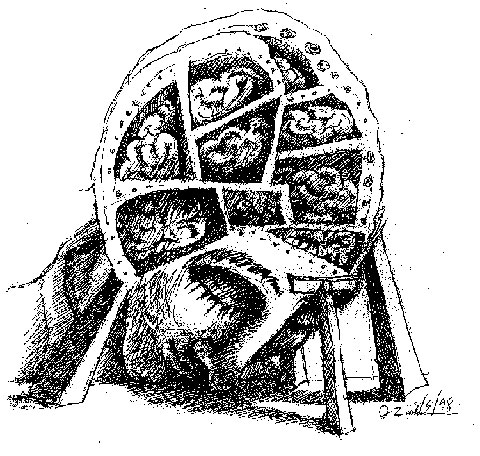
There is only one other source device I have personally heard that I appreciate as much as the Marantz SA-7S1, and that is the Walker Audio Proscenium turntable (as optioned and tricked out by Lloyd himself), at somewhere north of $30K.
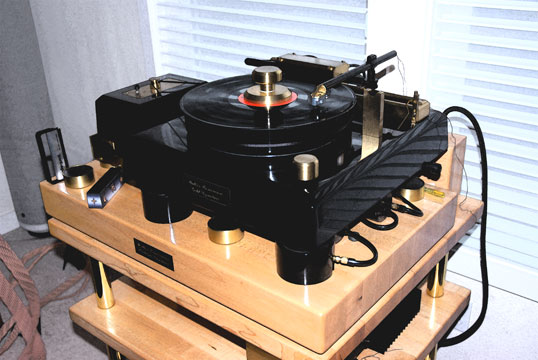
Heightening the allusion: a fresco of the Walker Audio Proscenium Black Diamon - photograph and image processing by Robinson
Amongst its reasonably identified peers, the Marantz simply has no equal. Oh, wait; didn't I say I wasn't going to do that? My bad.
In this land of X and Y, the Marantz is not so much towards the middle, as it is in rather another place. It has the resolution and detail at or near the best of the X's, and at the same time, this lyrical, effortless ability to capture the heart of the music like nothing else out there. Compared piece-by-piece, it may give up territory to some of the competition; as a whole, I find it to be the most musical and enduringly satisfying player currently extant.
Now when I hear other machines, I get restive, and either irritated or bored. I guess that is the most reliable indication I have found true and enduring love with the SA-7. I can tuck myself into the enveloping world of my system and happily while away the hours without fatigue or boredom. Heck, sometimes just for fun I do "pin the tail on the donkey" and just blind-grab something and slap it on for giggles.
I am done looking. As a sports-jock co-worker friend says, "I have my team in place."
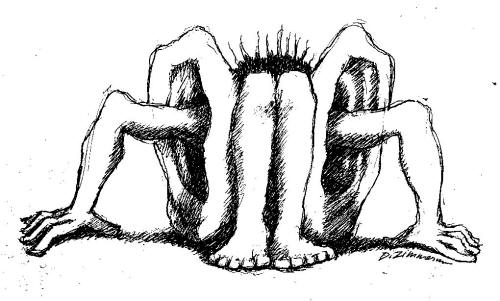
But …if you are the classic jittery angst-plagued audiophile pursuing showcase parts and pieces demonstration audio; if you are driven by fashion and some restless need to get to the molecular level in only the most carefully produced audiophile recordings, this is NOT the player for you. Look elsewhere …and if you are into the treacle of highly euphonic reproduction through reduced-response speakers, limited power and bandwidth amplifiers, and more romantic reproduction, this is also not the player for you. Look elsewhere.
Understand, I consider all of the machines I have mentioned to be very fine players, and the true differences amongst them I see as a function of taste …but before you plunk down a bunch of money, first be true to your own tastes (not what is PC or fashionable) or you will not be happy.
And, I have to offer yet another caveat. Marantz has recently released the SA-11S2 SACD player, a slightly downscale version of the SA-7, currently retailing for $3499. It shares many common components with its more expensive big brother, including the superb transport.
I have been badgered about doing a head-to-head comparison between these siblings, but the fact of the matter is that I am currently unable to obtain either a second SA-7 for a "second impression" review by David Robinson, or an SA-11S1 for myself, because Marantz insists on selling them to customers, and apparently they cannot make them fast enough.
Ironic, don't you think, that a "dying" format keeps having problems with sold out machines and software titles?
I have seen a lot of conjecture about the relative difference between the two machines, based on features, but since it would require purchasing an SA-11S1 to actually find out …I will have to wait until the demand dies back a bit.
So, Doc, How Does the SA-7 Sound?
As I wait with baited breath for my JENA Labs speakers (the cabinets are done, and now we are just waiting for the first four pair to be finished) as the "final touch" …at this moment, my system has evolved into a highly extended and powerful creature that does a convincing job between 14Hz and 45kHz, with pretty much whatever SPLs you can stand. Balance wise, it is a huge, wet kiss with its tongue down your throat, with a deep and widely drawn perspective. No glare, no grain, no compression at any livable volumes, and this unctuous, seductive liquidity that erases pretty much all of the criticism of even Redbook CD's.
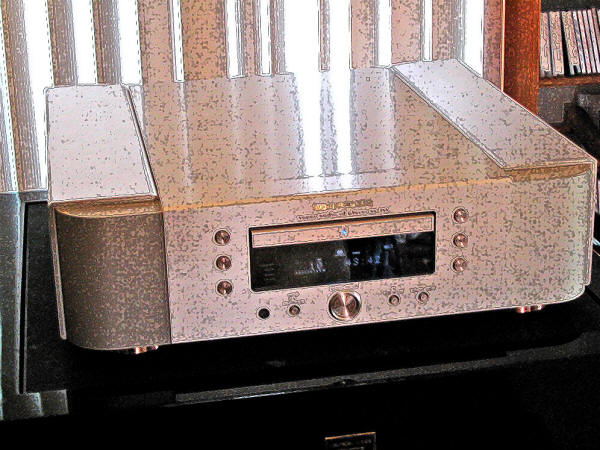
But let us be specific …
Ladysmith Black Mombazo, Long Walk to Freedom - SACD (Telarc Heads Up): I remember first actually seeing LBM on Saturday Night Live with Paul Simon, promoting Graceland. Granted, Graceland was a somewhat unfocused attempt to cash in on world music, but the luminous chants and singing of this multi-Grammy award winning, South African group (originally fronted by the late Joseph Shabalala) instantly converted me to a fan of twenty years' duration.
This 2006 SACD is both a sonic and musical tour de force, featuring such delightful guests as Melissa Etheridge, Emmylou Harris, Taj Mahal, Joe McBride, Sarah McLachlan, Natalie Merchant and Zap Mama, along with South African artists, Lucky Dube, Bhekumunzi Luthuli, Vusi Mahlasela, Hugh Masekela, Nokukhanya, Phuezkhemisi, and Thandiswa.
There are few things more difficult to reproduce convincingly than the human voice …and multiple human voices simply raise the difficulty by several orders; add to this the additional complexities of the trills and clicks (glottal stops) characteristic of native language, and you have a real system work out.
The additional headroom and resolution of SACD serves this recording wonderfully. The Marantz throws a huge stage laterally and subtly layered front to back, with even the head movement of the singers obvious in hearing the disc.
In a reprise of their contribution to Graceland, cuts three and four are "Diamonds on the Soles of Her Shoes," and "Homeless," with guest shots from Melissa Etheridge and with Joe McBride and Sarah McLaughlan, respectively.
A primary problem in reproducing a disc like this is maintaining the individual voices in the context of the whole ensemble without "smearing" them together unduly; balancing the whole, with the parts. The other problem is disembodied voices with no substance.
Not here, and not with the Marantz.
Although it is customary at this point to do an autopsy of the various pieces and parts of the experience such as imaging, PRAT, and toss in a host of adjectives, including those borrowed from other languages, mythology (Gee, I am glad I don't resort to those lame literary devices!) and such …I will just say that for all intents and purposes, the whole was without discernable flaw and if there were shortcomings, they never intruded into consciousness.
I don't mean to suggest that some poikliothermic, nitpicking self-appointed arbiter of the "absolute sound" would not be able to dig through the pleasure and fun in order to find some molecule out of place, but that is what it would require …and those sorts are never going to be satisfied with this player (or anything else for that matter), so we will fart in their general direction and move on.
For us living humans …we were couch-dancing and waxing rhapsodic …that between this disc and the Joe Weed and the Vultures SACD (coming up in a sec.), anyone who can hear and who loves music, would immediately understand the why of SACD, as heard through the Marantz.
However unromantic and un-PC this maybe, we didn't talk about the player much at all, or anything else about the equipment. We talked about the music, sang with the music, danced with the music, grinned with the music and generally had a joyous and innervating experience.
Yes, I said that, joy. Think of finishing a five-hour listening session, and feeling more energized than when you started, instead of having the ears beat off the side of your face.
I don't think anything else I have to say about this player is as significant as this one, summary observation: five hours of continuous listening at realistic volume levels without fatigue, and filled with the joy of the music. I simply don't know what else a music lover could want or expect.
Blue October, Foiled - CD (Brando/Universal Records)
Every day there is more hand-wringing on the net about more and more highly compressed recordings to feed portable, low resolution devices. This is a lamentable fact, but it is not universal. There are still good recordings being made of current music, although arguably they are less common than one should expect. But then pop music has always been driven by market issues such as the three minute limit, crappy compression, noise-gating, and laughable reverb (drag out America's "Horse with No Name" for a real hoot, in this regard).
I will say that on the EMM Labs CDSA SE, Jennifer Crock found this disc unlistenable (she isn't that big a fan of a lot of modern rock music). When the same disc was presented without comment on the Marantz, she loved it, and was befuddled when reminded she could not tolerate it previously.
I think that is pretty indicative. It is also indicative that she is ordering an SA-7 for her own use.
The RCA recording of Scheherazade (Reiner/Chicago) CD is a venerable classic. You would have to be living in a mud hut somewhere not to know it. The CD is fine, but not overly impressive. I have heard it a hundred times. One night after dinner, I was in a nostalgic mood, so I put it on and cozied up to my lady friend and we listened without break and without pause to the entire recording.
One of my enduring frustrations with classical recordings of orchestral works is the diminution in size and weight. Instruments too often float in space without substance. The whole effect is tiny and toy-like.
I would not hyperbolically suggest I was able to re-create the Chicago Symphony in my human-sized listening room, but I will assert I have never heard this recording with the scale, weight and grounding I got from the combination of the Marantz and the VMPS/HSU speakers. The edges of the sound stage extended well outside the boundaries of the mains, and reached from my listening position back some fifteen feet or better to the back boundary of the room.
That plaintive, isolated violin …now there was also the body of the instrument, not just a Jiminy Cricket-sized outline.
We finished the experience with a sigh of satisfaction; talked a bit about our shared love for romantic music and toddled off to bed, replete and relaxed.
Joe Weed, The Vultures - SACD (Top Music) This is one of those high-concept albums executed by well-known artists who aren't really a band, in the ongoing sense of that term (Traveling Wilburys, Golden Smog, etc.). And if I were going to recommend one SACD that is perfectly executed to show the difference between RB and SACD, this is the one.
First of all, we are talking Joe Weed, guitar, fiddle, mandolin, with Norton Buffalo on harmonica, the memorable David Grisman on mandolin (Remember Dawg Music?), Rob Ickes on dobro, and Todd Phillips on bass. The subject matter? The Ventures, Surfaris, Floyd Cramer, Bobby Rydell, Booker T and the MG's, Duane Eddy …all done with accordion and dobro … sounds absolutely nuts, doesn't it? Kinda like Django Reinhart meets Doc Watson, and they go back to that magic time when the fifties turned into the sixties.
I remember the first night a teen band I was in managed to obtain a Hammond B-3 (from a hapless and presumably infirm and aged relative) with a twin-reverb Leslie, and we did "Green Onions" as our opening tune. Hearing it now done with accordion is an absolute hoot.
If you know this music in its original form, you will grin through the whole album; if you are too young to understand that the Hokey Pokey may just be what it is all about, and you have no idea who Dale Shannon is …you may mistake it for some sort of demented elevator music. Oh, and if you have no discernable sense of humor or whimsy, well, you should instead just pull out some Bartok or Patricia Barber, step on a puppy, and move on.
The playing is perfect, even when they have their collective tongues firmly in cheek and the recording is simply one of the most natural and pleasing examples of a well-done SACD studio product.
As we listened and laughed, we talked about how we wish they would reconvene to do up Jan and Dean, the Beach Boys, and Dick Dale. Ah well …
Conclusion
I have not purchased a player since the Sony SCD-1, and had no intentions of doing so until the SA-7 made its way into my life. I figured to wander aimlessly from review unit to review unit; but this all changed with the Marantz. Like JENA Labs, Critical Mass and Ming Da, I knew this piece was not leaving my room, unless pried from my hands (I feel the same way about the Hsu sub and mid-bass units, but I have not yet had that conversation with Dr. Hsu)!
If you have reached a point in your life where you have the desire and the wherewithal for the best, and you are all grown up and truly a music lover first and an audiophile secondarily …please take the time and opportunity to hear a fully run-in SA-7S1 (under about 200 hours, you will not know what its true capabilities are).
I also suggest that, based on family resemblance, if the SA-7 is too dear, you might want to give the little brother SA-11S1 a listen. I cannot comment personally, but the buzz is very similar to that surrounding the SA-7.
Whatever fashionably hip detractions you may hear … go listen for yourself; you just may find in this field of polarized machines, the SA-7 is exactly what the doctor ordered.
